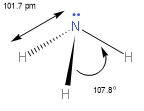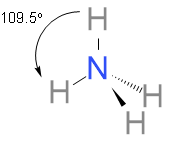
When $\text{N}{{\text{H}}_{\text{3}}}$ is treated with HCl, $\text{H -- N -- H}$ bond angle:
A. increases
B. decreases
C. remains same
D. depends upon temperature
Answer
589.2k+ views
Hint: The increase or decrease of the bond angle of a compound is determined by the s character. By s character we mean the s hybridisation. So, to determine the increase or decrease of the bond angle, we need to find the hybridisation of the compound.
Complete step-by-step answer:
We know that $\text{N}{{\text{H}}_{\text{3}}}$ has a bond angle of $\text{107 }\!\!{}^\circ\!\!\text{ }$. This bond angle is less as compared to the tetrahedral angle, owing to the increase in the repulsion to bond pairs. This happens due to the presence of lone pairs of nitrogen.
Now on reacting with HCl, $\text{N}{{\text{H}}_{\text{3}}}$ results in the formation of $\text{N}{{\text{H}}_{\text{4}}}\text{Cl}$. The reaction is given below:
$\text{N}{{\text{H}}_{\text{3}}}\text{ }+\text{ HCl}\xrightarrow{{}}\text{ N}{{\text{H}}_{\text{4}}}\text{Cl}$
In this case, $\text{N}{{\text{H}}_{\text{4}}}^{\text{+}}$ has no longer any lone pair at nitrogen. Hence, the ammonium ion is perfectly tetrahedral, just like the $\text{C}{{\text{H}}_{\text{4}}}$. So, now the bond angle is $\text{109}\text{.5 }\!\!{}^\circ\!\!\text{ }$.
Therefore, we can say that when $\text{N}{{\text{H}}_{\text{3}}}$ is treated with HCl, $\text{H -- N -- H}$ the bond angle increases.
So, the correct answer is Option A.
Both $\text{N}{{\text{H}}_{\text{3}}}$ and $\text{N}{{\text{H}}_{\text{4}}}^{\text{+}}$ are $\text{s}{{\text{p}}^{\text{3}}}$ hybridized. Here is the structure of both of the structures.


Note: Angle between two adjacent bonds at an atom in a molecule made up of three or more atoms is known as the bond angle. Bond angle is affected by the presence of a lone pair of electrons at the central atom.
The electronegativity of elements decreases as we move down the group. The lone pair - bond pair repulsion is stronger as compared to the lone pair - lone pair or bond pair - bond pair interaction. But as electronegativity decreases, the repulsion also decreases which results in a decrease in bond angle.
Complete step-by-step answer:
We know that $\text{N}{{\text{H}}_{\text{3}}}$ has a bond angle of $\text{107 }\!\!{}^\circ\!\!\text{ }$. This bond angle is less as compared to the tetrahedral angle, owing to the increase in the repulsion to bond pairs. This happens due to the presence of lone pairs of nitrogen.
Now on reacting with HCl, $\text{N}{{\text{H}}_{\text{3}}}$ results in the formation of $\text{N}{{\text{H}}_{\text{4}}}\text{Cl}$. The reaction is given below:
$\text{N}{{\text{H}}_{\text{3}}}\text{ }+\text{ HCl}\xrightarrow{{}}\text{ N}{{\text{H}}_{\text{4}}}\text{Cl}$
In this case, $\text{N}{{\text{H}}_{\text{4}}}^{\text{+}}$ has no longer any lone pair at nitrogen. Hence, the ammonium ion is perfectly tetrahedral, just like the $\text{C}{{\text{H}}_{\text{4}}}$. So, now the bond angle is $\text{109}\text{.5 }\!\!{}^\circ\!\!\text{ }$.
Therefore, we can say that when $\text{N}{{\text{H}}_{\text{3}}}$ is treated with HCl, $\text{H -- N -- H}$ the bond angle increases.
So, the correct answer is Option A.
Both $\text{N}{{\text{H}}_{\text{3}}}$ and $\text{N}{{\text{H}}_{\text{4}}}^{\text{+}}$ are $\text{s}{{\text{p}}^{\text{3}}}$ hybridized. Here is the structure of both of the structures.


Note: Angle between two adjacent bonds at an atom in a molecule made up of three or more atoms is known as the bond angle. Bond angle is affected by the presence of a lone pair of electrons at the central atom.
The electronegativity of elements decreases as we move down the group. The lone pair - bond pair repulsion is stronger as compared to the lone pair - lone pair or bond pair - bond pair interaction. But as electronegativity decreases, the repulsion also decreases which results in a decrease in bond angle.
Recently Updated Pages
Why are manures considered better than fertilizers class 11 biology CBSE

Find the coordinates of the midpoint of the line segment class 11 maths CBSE

Distinguish between static friction limiting friction class 11 physics CBSE

The Chairman of the constituent Assembly was A Jawaharlal class 11 social science CBSE

The first National Commission on Labour NCL submitted class 11 social science CBSE

Number of all subshell of n + l 7 is A 4 B 5 C 6 D class 11 chemistry CBSE

Trending doubts
1 Quintal is equal to a 110 kg b 10 kg c 100kg d 1000 class 11 physics CBSE

What is Environment class 11 chemistry CBSE

Bond order ofO2 O2+ O2 and O22 is in order A O2 langle class 11 chemistry CBSE

How many squares are there in a chess board A 1296 class 11 maths CBSE

Distinguish between verbal and nonverbal communica class 11 english CBSE

The equivalent weight of Mohrs salt FeSO4 NH42SO4 6H2O class 11 chemistry CBSE




